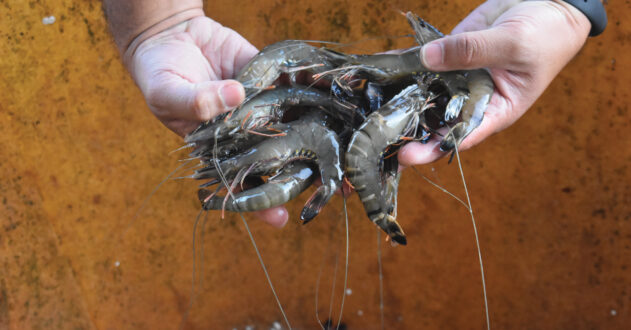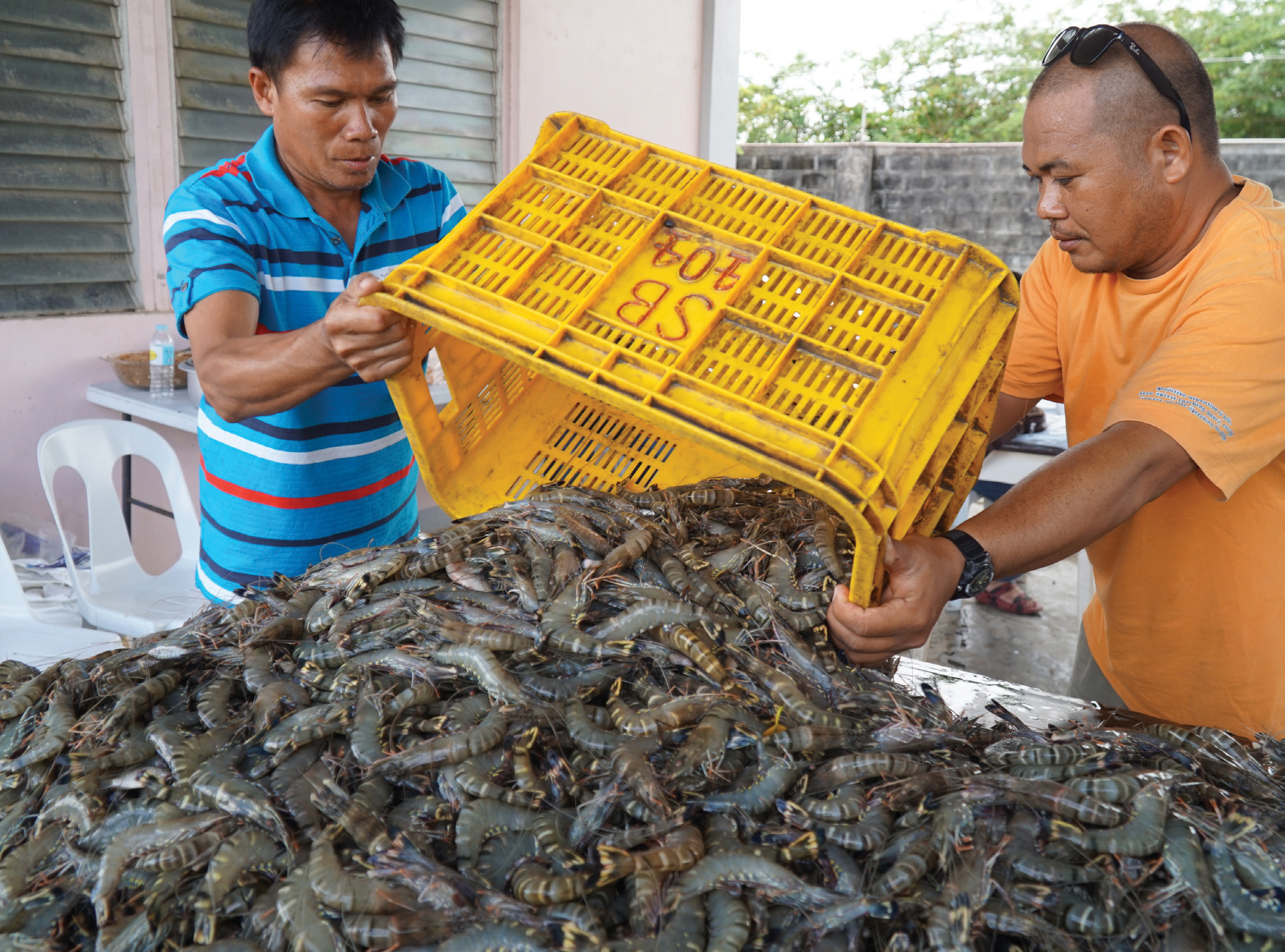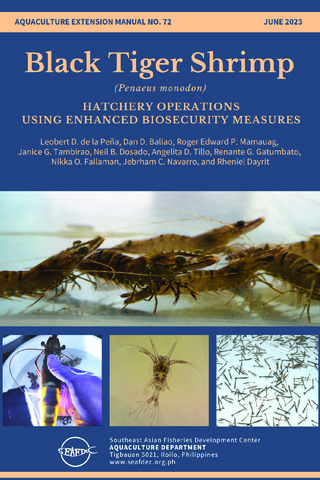
THE PROBLEM
Tiger shrimp culture, a million-dollar export industry in the nineties, struggles to recover
Production of tiger shrimp (Penaeus monodon) in the Philippines suffered a drastic decline back in the late 1990s. The country used to rank among the top 10 shrimp-producing countries in the world with production peaking at 90,426 metric tons in 1994. In 1995, government estimated the production output at 88,815 tons valued at 19 billion pesos.1
However, the industry was ill-prepared for intensification and the rampant use of unapproved chemicals and release of untreated wastewater into the environment triggered the emergence of a series of shrimp diseases that plague the industry until now.
Despite its high value, tiger shrimp production in 2018 stood at only 44,780.22 metric tons.2
SOLUTIONS
- Promotion of eco-friendly strategies and effective biosecurity
- Production of high quality shrimp larvae
ECONOMIC VALUE
- Despite mainly extensive production, the tiger shrimp industry is still worth at least P15 billion
- Rehabilitation of the industry could at least double the production with less impact to the environment
- Tiger shrimp is a high-value commodity with high demand both in the domestic and export markets
1Bureau of Agricultural Statistics, 1996
2BFAR Online Information System 2018
What has SEAFDEC/AQD been doing?
2018: Enhanced biosecurity in new shrimp hatchery
The shrimp hatchery complex was prepared to provide high quality shrimp fry to be stocked in ponds. Enhanced biosecurity operations were implemented beginning with a spawner/broodstock facility. The facility is located outside the shrimp hatchery and serves to quarantine newly-arrived spawners and to sample spent spawners for the possible presence of pathogens. After spawning and analyses, nauplii from positive spawners are chlorinated and discarded while nauplii from negative spawners are stocked in the larval rearing facility located at the shrimp hatchery.
The hatchery is equipped with biosecurity features to prevent or lessen the accumulation of pathogens. A disinfection building was built for hatchery staff and visitors. Visitors are not allowed to enter the facility within 48 hours after visiting other hatcheries or farms. Rapid sand filters, UV sterilizers, filter bags, and enclosed larval rearing facilities ensure good quality rearing water. Larval rearing tanks are divided into two modules which allows resting of the other module after a run. Rearing water is sampled twice a week while the stocked fry are sampled at PL 5, PL 10 and PL 15 stage to make sure that they are disease-free before harvest.

Biosecure quarantine facility for holding and testing new tiger shrimp spawners
2019: Demonstration of eco-friendly pond culture
The technology demonstration projects for this program was divided into two phases. The first phase began in the Dumangas Brackishwater Station with the technology demonstration runs of low or partial discharge and closed-recirculating system of shrimp farming using environment-friendly schemes at the intensive, semi-intensive, and modified extensive levels of production. Successful technology demonstration runs will then be followed by the implementation of Phase 2 where demonstration will be done in private commercial shrimp farms.
In July 2019, disease-free fry were stocked in DBS to begin the experimental grow-out run using environment-friendly strategies. In October 2019, over 2.8 tons of tiger shrimp were harvested from a 0.5-hectare pond. After 113 days of culture, 93.3 % of the 100,000 PLs survived and attained an average body weight of 30 grams.
In November 2019, another 4.4 tons of tiger shrimp, with an average body weight of 30 g, were harvested from a 0.8-hectare pond after 120 days of culture, yielding a survival rate of 89.7 %. More runs will be conducted to verify the culture system in 2020. Once verified and proven effective, the technology will be adopted by BFAR Region 6 to be demonstrated in their technology outreach stations in Negros and Aklan and will be introduced to fish farmers.

Tiger shrimp harvested from SEAFDEC/AQD’s Dumangas Brackishwater Station during a demonstration of environment-friendly strategies in shrimp culture in Oct. 2019
2022: Establishment of a tiger shrimp broodstock facility
A biosecure tiger-shrimp broodstock facility was built at SEAFDEC/AQD in 2022 to mass-produce disease-free captive broodstock. This was to eventually reduce reliance on wild shrimp spawners that often carry diseases which are then passed on to their eggs and larvae. The heart of the facility are four 120-ton broodstock tanks, with a combined holding facility of 1,440 fully-grown breeders, which are projected to produce 80 million postlarvae annually. More importantly, the facility is hoped to be a source of disease-free captive broodstock which are critical to achieving high survival rates and the production of high-quality postlarvae in the hatchery.
After its inauguration in 2023, about 4,000 tiger shrimp (Penaeus mondon), that were tested to be negative for key diseases, were stocked in the broodstock tanks . The shrimp originated from SEAFDEC/AQD’s shrimp hatchery and grown to about 27 grams each at the Dumangas Brackishwater Station. Having been reared entirely in SEAFDEC/AQD’s facilities, the new batch of shrimp are being groomed to become fully domesticated and disease-free broodstock and, again, complete the life cycle of tiger shrimp in captivity, a feat first accomplished by SEAFDEC/AQD in 1975.
2023: Publication of extension manual on biosecure hatchery operations
Protocols developed in the SEAFDEC/AQD Tiger Shrimp Hatchery have been compiled and published in an extension manual, “Black Tiger Shrimp (Penaeus monodon) Hatchery Operations Using Enhanced Biosecurity Measures,” which was launched in July 2023. Discussed in the manual are the necessary protocols and biosecurity measures that shrimp hatchery operators can use. Topics covered include site selection, tiger shrimp biology, hatchery layout, facilities and equipment, biosecurity standard operating procedures, hatchery operations, diseases of shrimps, and economic analysis.

 SEAFDEC/AQD Southeast Asian Fisheries Development Center | Aquaculture Department
SEAFDEC/AQD Southeast Asian Fisheries Development Center | Aquaculture Department